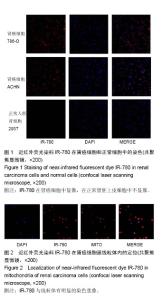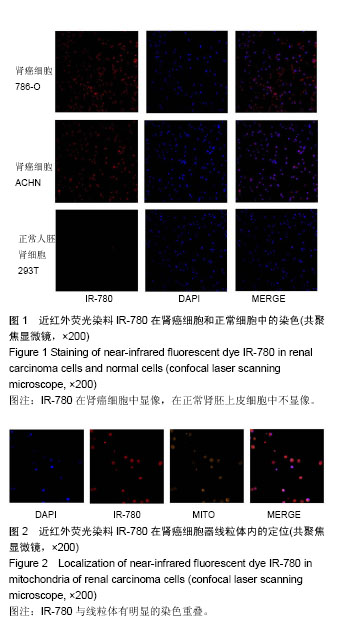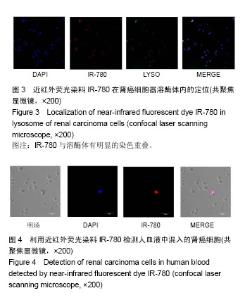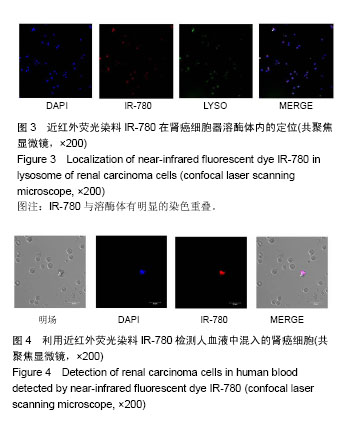| [1] Torre LA,Bray F,Siegel RL,et al.Global cancer statistics, 2012.CA Cancer J Clin.2015;65:87-108.[2] Fitzmaurice C,Dicker D,Pain A,et al.The Global Burden of Cancer 2013. JAMA Oncol.2015;1:505-527.[3] Miller KD,Siegel RL,Lin CC,et al.Cancer treatment and survivorship statistics, 2016. CA Cancer J Clin.2016;66:271-289.[4] Siegel RL,Miller KD,Jemal A.Cancer Statistics, 2017.CA Cancer J Clin. 2017;67:7-30.[5] Prokofiev D,Kreutzer N,Kress A,et al.Small renal mass.Urologe A.2012; 51(10):1459-1465, 1466-1468.[6] Ficarra V,Bhayani S,Porter J,et al.Predictors of warm ischemia time and perioperative complications in a multicenter, international series of robot-assisted partial nephrectomy.Eur Urol.2012;61(2):395-402.[7] Ljungberg B,Bensalah K,Canfield S,et al.EAU guidelines on renal cell carcinoma: 2014 update. Eur Urol.2015;67(5):913-924.[8] Biffi S,Garrovo G,Maeor P,et al.In vivo biodistribution and lifetime analysis of Cy5.5-connjugated ritaximab in mice bearing lymphoid tumor xenograft using time-domain near-infrared optical imaging.Mol Imaging.2008;7(6):272-282. [9] Medarova Z,Rashkovetsky L,Pantaztpoulos P,et al.Multiparametric monitoring of tumor response to chemotherapy by noninvasive imaging. Cancer Res.2009;69(3):1182-1189. [10] Yi X,Wang F,Qin W,et al.Near-infrared fluorescent probes in cancer imaging and therapy: an emerging field.Int J Nanomedicine.2014;9: 1347-1365.[11] Guo Z,Park S,Yoon J,et al.Recent progress in the development of near-infrared fluorescent probes for bioimaging applications.Chem Soc Rev.2014;43(1):16-29.[12] Hilderbrand SA,Weissleder R.Near-infrared fluorescence: application to in vivo molecular imaging.Curr Opin Chem Biol.2010;14(1):71-79.[13] Yang X,Shao C,Wang R,et al.Optical imaging of kidney cancer with novel near infrared heptamethine carbocyanine fluorescent dyes.J Urol.2013;189(2):702-710.[14] Siegel RL,Miller KD,Jemal A.Cancer statistics, 2016.CA Cancer J Clin.2016;66(1):7-30. [15] Chen W,Zheng R,Zeng H,et al.The incidence and mortality of major cancers in China, 2012.Chin J Cancer.2016;35(1):73.[16] 叶章群,孙颖浩,那彦群,等.中国泌尿外科疾病诊断治疗指南[M].北京:人民卫生出版社,2014.[17] Caputo PA,Ramirez D,Zargar H,et al.Laparoscopic Cryoablation for Renal Cell Carcinoma: 100-Month Oncologic Outcomes.J Urol. 2015; 194(4):892-896.[18] Tan HJ,Norton EC,Ye Z,et al.Long-term survival following partial vs radical nephrectomy among older patients with early-stage kidney cancer.JAMA.2012;307(15):1629-1635.[19] Hilderbrand SA,Weissleder R.Near-infrared fluorescence: application to in vivo molecular imaging.Curr Opin Chem Biol.2010;14(1):71-79.[20] Yang X,Shi C,Tong R,et al.Near IR heptamethine cyanine dye-mediated cancer imaging.Clin Cancer Res. 2010;16(10): 2833-2844.[21] 贺丽芳,黄文河,张国君.恶性肿瘤的光学分子影像手术导航[J].中国肿瘤临床,2016,43(21):927-931.[22] Shi C,Zhang C,Su Y,et al.Cyanine dyes in optical imaging of tumours. Lancet Oncol.2010;11(9):815-816.[23] Zhang C,Wang S,Xiao J,et al.Sentinel lymph node mapping by a near-infrared fluorescent heptamethine dye.Biomaterials. 2010;31(7): 1911-1917.[24] 田迎,卢光明,郑玲 近红外荧光染料用于肿瘤检测的初步研究[J].医疗卫生装备,2015(10):24-26.[25] Zhang E,Luo S,Tan X,et al.Mechanistic study of IR-780 dye as a potential tumor targeting and drug delivery agent.Biomaterials. 2014; 35(2):771-778.[26] Yi X,Zhang J,Yan F,et al.Synthesis of IR-780 dye-conjugated abiraterone for prostate cancer imaging and therapy.Int J Oncol. 2016; 49(5):1911-1920.[27] Kawaguchi M,Hara N,Bilim V,et al.A diagnostic marker for superficial urothelial bladder carcinoma: lack of nuclear ATBF1 (ZFHX3) by immunohistochemistry suggests malignant progression. BMC Cancer. 2016;16(1):805.[28] Wu JB,Shao C,Li X,et al.Near-infrared fluorescence imaging of cancer mediated by tumor hypoxia and HIF1alpha/OATPs signaling axis. Biomaterials.2014;35(28):8175-8185.[29] Tian Y,Sun J,Yan H,et al.A rapid and convenient method for detecting a broad spectrum of malignant cells from malignant pleuroperitoneal effusion of patients using a multifunctional NIR heptamethine dye. Analyst. 2015;140(3):750-755. |



